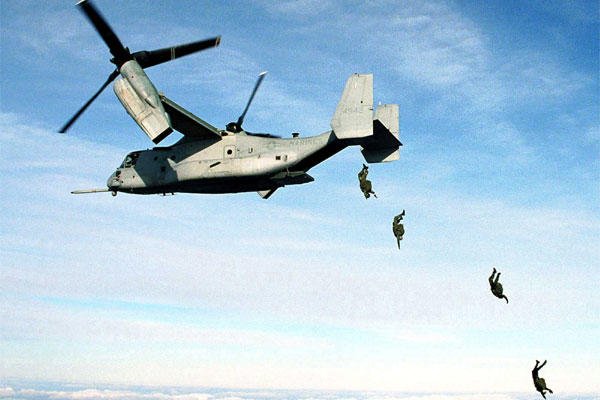The U.S. Marine Corps is preparing to deploy an agile, rapid crisis response force to the Mediterranean with deployable combat power, air assets, sea-basing and maritime pre-positioning capabilities, Corps leaders said March 8 at the Sea-Air-Space Expo, National Harbor, Md.
"This will give senior leaders some decision space. It can integrate with an MEU and augment or compliment fleet anti-terrorism support teams," said Lt. Gen. Richard Tryon, Deputy Commander for Plans, Policies and Operations.
The roughly 500-Marine response force will be equipped with six MV-22 Ospreys and two KC -130J turbo-prop military transport aircraft, he said.
Deployment of the force has already been approved by the Defense Secretary and plans are currently being finalized, Tryon said.
While not quite equipped at the level of a Marine Expeditionary Unit, the rapid crisis response force is designed to give combatant commanders additional quick-response options.
The idea is for the small, agile force to closely coordinate with forward positioned Naval forces in order to retain an expeditionary, coordinated capability.
Navy and Corps leaders talked Monday at the Sea Air Space Expo at National Harbor, Md., about the U.S. military's pivot to the Pacific theater and the increasingly probability that their services would be called upon to respond to a wide-range of potential contingencies.
"One of the areas where have operational innovation currently meeting with technological innovation is with our special purpose crisis response force. It is a small, tailored combat organization that will forward deploy into the Mediterranean, North African region," Tryon said.
He talked about how the earth is covered by 70-percent water and that 95-percent of the world's commercial cargo will travel by sea, further underscoring the need for Navy and Corps forces to be both expeditionary and strategically forward-deployed around the globe.
Along these lines, both Marine Corps and Naval leaders discussed a broad, general sketch of a range of potential threat scenarios characterizing the years to come, including state and non-state actors, criminal and terrorist groups, as well as humanitarian crises and natural disasters.
"I don't know what the next decade is going to be. There will be a lot of crisis out there and we're already going to be forward deployed so we are going to be able to bring capability to bear. We will bring two attributes -- physical and political access from our ships and submarines that we can bring to bear on a crisis," said Adm. William E. "Bill" Gortney, Commander, U.S. Fleet Forces Command.





























